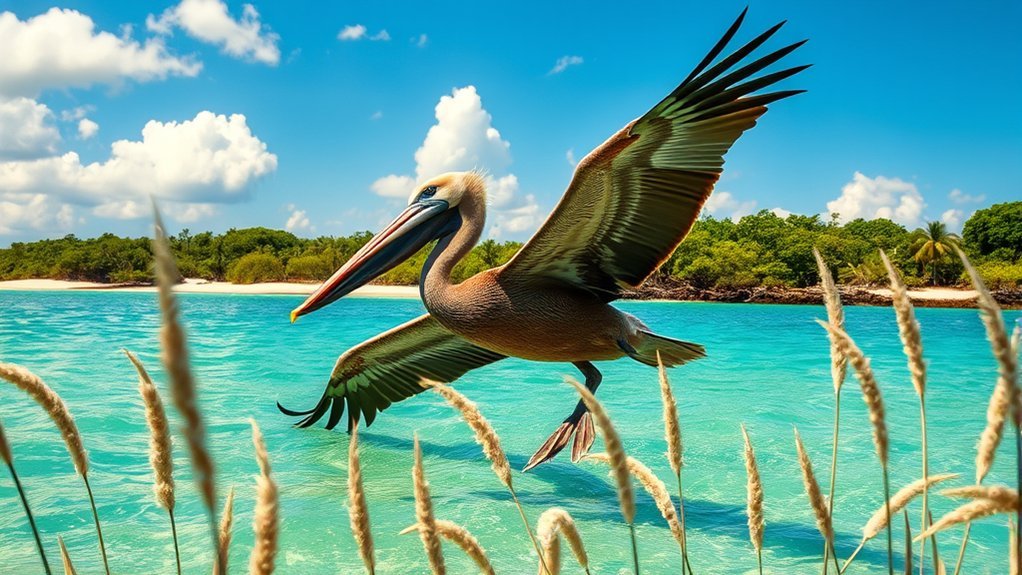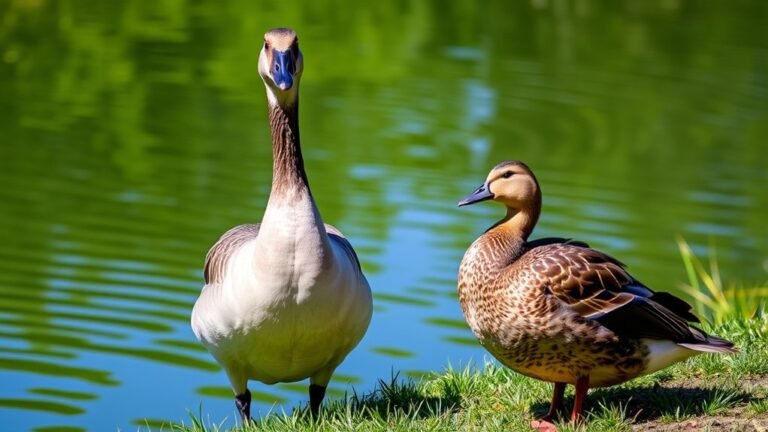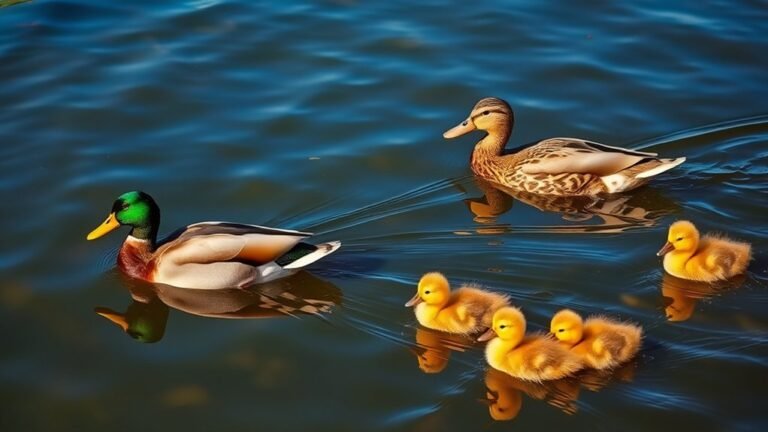All About the Brown Pelican: Facts and Habitats
The Brown Pelican is a cool bird found along the coast. It's big and can dive from high up to catch fish. This makes it really special! But, the places where they live are in danger because of changes in the environment.
Let's look at what makes the Brown Pelican unique. They are strong fliers and have a colorful body. They often work together to find food, which is pretty neat! However, they need our help to stay safe and healthy in their homes.
There is so much more to learn about these amazing birds. What else do you think makes the Brown Pelican interesting?
A Quick Overview
Brown Pelicans are big birds. They can be between 40 and 54 inches long. Their wings can stretch out to 7 feet!
When they are hunting for fish, Brown Pelicans like to dive into the water. They can dive from as high as 60 feet. Sometimes, they work together to catch food.
These birds like to nest in quiet, coastal areas. They build their nests using sticks and seaweed. Both mom and dad Pelican help with building the nest.
Thanks to conservation efforts, Brown Pelicans are coming back in number. But pollution and loss of their homes are still big problems for them.
Brown Pelicans are important to coastal culture. They help people connect with nature and inspire them to care about the environment.
Physical Characteristics of the Brown Pelican

The Brown Pelican is a big bird that stands out because of its large wings and long bill.
These birds come in different sizes. They can be anywhere from 40 to 54 inches long and their wings can reach up to 7 feet across. This size can change depending on where they live and what food is around.
Their feathers are another interesting feature. Adult Brown Pelicans have a mix of light and dark brown feathers while baby pelicans are mostly dark.
As they grow up, their feathers change to the adult colors. This big difference helps people recognize the birds and makes watching them more fun.
Learning about these traits helps us appreciate how important the Brown Pelican is in nature.
Unique Diving Techniques
Brown Pelicans are amazing birds. They're big and have beautiful feathers.
One of their coolest skills is how they dive to catch fish. They can dive from as high as 60 feet in the air!
When they dive, they go in head-first. This helps them aim at fish better. The splash when they hit the water can confuse the fish, making it easier for the pelicans to catch them.
These birds have great eyesight. They look down from above to find schools of fish.
Then, they fly straight down for the best chance to catch dinner. Their diving skills show how good they're at hunting, making every meal count!
Feeding Habits and Diet

While watching a Brown Pelican in the wild, you'll see its interesting way of feeding, mostly focusing on fish. These birds have amazing skills that help them catch food.
Here are three main points about how Brown Pelicans eat:
- Plunging: Pelicans dive into the water from high above. They use their big beaks to scoop up fish while they're under the surface.
- Sharp Eyesight: These birds can see really well. They can spot fish schools swimming just below the water.
- Teamwork: Sometimes, you'll see Pelicans working together. They help each other push fish into shallow water, making it easier to catch.
With these simple but effective methods, Brown Pelicans show how well they fit into their watery homes.
It's fascinating to see how they hunt and gather food!
Breeding and Nesting Behavior
Brown Pelicans are amazing birds, and they've interesting ways of breeding and nesting. They like to pick safe places to lay their eggs, often on remote islands or cozy coastal spots. This keeps them away from predators.
During mating season, male pelicans show off to attract their mates. They puff out their throat pouches and dive into the water to impress the female.
Once they find a partner, both birds work together to choose a good nesting site. They build their nest using twigs and seaweed.
After the female lays her eggs, both parents take turns sitting on them to keep them warm and safe. This teamwork not only helps them stay close but also gives their chicks a better chance to survive.
Brown Pelicans really show how families can work together!
Migration Patterns

Pelicans are interesting birds, and their migration patterns show how well they adapt to the environment. They travel to different places for three main reasons:
- Temperature Changes: When it gets cold, pelicans fly to warmer areas. They do this to stay comfortable and safe from the cold weather.
- Food Availability: Pelicans look for places with lots of fish and other food. If they find a spot with plenty of food, they'll travel far to get there.
- Breeding Cycles: After they breed, pelicans move to safe places where they can spend the winter. These areas have enough food and safety to help them survive the cold months.
Understanding these reasons helps us learn more about how pelicans live and thrive.
Habitats and Range
Brown pelicans live near the coast. They like places with lots of food and safe spots to build their nests. You can find them on sandy beaches, in marshes, and near lagoons. These areas have plenty of fish, which is their favorite food.
You will see brown pelicans along the Atlantic, Pacific, and Gulf coasts. They enjoy places where there's a lot of marine life. Pelicans often choose rocky areas or quiet little islands to make their homes. Finding safe places to nest is really important for them. These spots help protect their babies from predators.
Conservation Status
The brown pelican is doing much better now than it was in the past. This change happened because people worked hard to protect their homes and clean up their environment.
Here are some important ways that helped the brown pelican recover:
- Protecting Habitats: We keep safe places for pelicans to live, like coastal wetlands and nesting areas. This helps them survive and raise their young.
- Cleaning Up Pollution: Rules about using harmful chemicals and waste have made their homes cleaner. This means fewer toxins are in the water and air.
- Spreading Awareness: People share information about pelicans, helping everyone understand why these birds are important. When communities care, they help look after these beautiful creatures.
Thanks to these efforts, the brown pelican has a brighter future!
Threats to the Brown Pelican
The brown pelican is coming back, but it still has some big problems. Pollution is a major issue. Chemicals from pesticides and plastic waste make their food dirty and harm their health.
This can lead to fewer baby pelicans because they can't reproduce as well. These harmful chemicals can build up inside their bodies and weaken their immune systems.
Another big problem is habitat loss. People build on the coast, which takes away the places where pelicans nest and find food.
Climate change also affects their homes and food supply.
It's important for us to know about these issues. By speaking up for better care of our environment, we can help protect the brown pelican and where it lives.
Let's work together to make a difference!
The Role in Ecosystems
Pelicans are important birds that help keep nature in balance. They're both hunters and signs of how healthy the environment is.
Let's look at how they help their ecosystems:
- Hunting: Pelicans eat fish. By eating certain amounts, they help keep the fish population healthy and varied.
- Feeding: When pelicans catch and eat fish, they spread nutrients in the water. This helps plants and other animals grow.
- Health Signals: If pelicans start to get sick or have fewer babies, it can mean something is wrong in their environment. This helps workers know when to step in and help nature.
Pelicans aren't just cool birds; they play big roles in keeping their homes healthy.
Interesting Behaviors
Brown pelicans are really interesting birds. Watching their behaviors can tell us a lot about how they adapt and interact with each other. During mating season, male pelicans show off to attract mates. They do this with cool flying tricks and sounds. These displays help them find partners and also make their groups stronger.
When it comes to food, pelicans often fish together. They work as a team to catch their meals. This shows how well they communicate with each other.
There's a social structure among pelicans, which can impact who gets to eat and who gets to breed. By observing these behaviors, we can better understand how brown pelicans live and thrive in their surroundings.
They've a unique way of forming communities and sharing resources.
Brown Pelican Cultural Significance
The brown pelican is important in many cultures, especially in coastal areas. This bird represents strength and the ability to adapt.
People show their love for the pelican in different ways. Here are three main areas where the brown pelican makes a difference:
- Art: Many artists draw or sculpt pelicans. They capture the bird's beauty and elegance.
- Folklore: Stories often tell about the pelican's caring nature. These tales remind families to value looking after one another.
- Conservation Efforts: The pelican symbolizes protecting the environment. It brings communities together to save coastal areas.
In these ways, the brown pelican helps you connect with nature. It gives you a sense of belonging and adds to your cultural identity.
How to Spot a Brown Pelican in the Wild
How can you spot a brown pelican in the wild? First, go to coastal areas like beaches, estuaries, and fishing piers. These spots are perfect for finding them.
Bring binoculars to see them better. Look for their special brown feathers and big, long bills.
Watch how they catch fish! Brown pelicans dive into the water from the sky, making a big splash. The best times to see them are early in the morning and late in the afternoon when they're hunting for food.
You can also listen for their unique calls. This will help you find them, even if you can't see them right away.
Using these tips will help you enjoy the beauty of brown pelicans in nature!
Frequently Asked Questions
What Is the Average Lifespan of a Brown Pelican?
The average lifespan of a brown pelican is about 10 to 15 years. Their lifespan can change based on what they eat and their living environment. It can be hard to tell how old a pelican is just by looking at it. You often need to watch their look and actions over time to get an idea of their age.
How Do Brown Pelicans Communicate With Each Other?
Brown pelicans talk to each other using sounds and their bodies. They make calls that sound different in pitch and loudness. For example, some calls are high, while others are low. Their body movements also show how they feel. When they stand tall with their wings out, they might feel calm. If they hunch down or flap their wings quickly, they could be worried or upset. This way, they share feelings and build friendships within their groups.
What Predators Threaten Brown Pelican Chicks?
Brown pelican chicks have a tough start in life. They face many dangers from animals that want to eat them. Some of the main predators include raccoons, gulls, and crows.
If you are watching these chicks, be sure to look out for these predators. They can hurt the little pelicans and affect how many of them survive each nesting season. It's important to help keep an eye on these young birds so they can grow up safe!
Are Brown Pelicans at Risk During Oil Spills?
Brown pelicans are in danger during oil spills. The oil can harm their feathers and damage the places where they live. When their feathers get oily, they lose their ability to stay warm and dry. This can lead to serious health issues.
Conservation efforts are important to help brown pelicans. By supporting these efforts, we can protect these beautiful birds and their homes. Simple actions can make a big difference. Together, we can ensure that brown pelicans stay safe and healthy in their natural habitats.
Can Brown Pelicans Swim Well on Their Own?
Yes, pelicans swim very well. They have strong wings and powerful legs that help them move through water easily. When they look for fish, they dive right in, showing off their great swimming skills. Pelicans can glide along the water's surface and swim efficiently. It's impressive to watch them in action!

Luna is the passionate founder and author of Birds and You, a website dedicated to sharing her love for birds with fellow enthusiasts. Through her engaging articles and guides, she aims to educate and inspire others to explore the fascinating world of birds. When she’s not writing, you can find Luna observing birds in their natural habitats or sharing beautiful bird photography on Pinterest. Join her on this journey to celebrate and protect our feathered friends!







